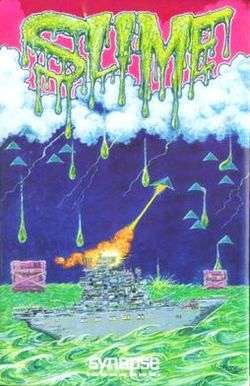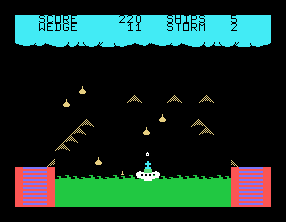Slime (video game)
| Slime | |
|---|---|
 | |
| Publisher(s) | Synapse Software |
| Designer(s) | Ihor Wolosenko |
| Programmer(s) | Steve Hales |
| Platform(s) | Atari 8-bit |
| Release date(s) | 1982 |
| Genre(s) | action |
| Mode(s) | single or two player |
Slime is a 1982 video game for the Atari 8-bit series written by Steve Hales and distributed by Synapse Software. The player attempts to protect their ship from a rain of enormous drops of slime by deflecting them into huge canisters, while fending off attacks by an alien flying saucer.
Slime, under the title Super Storm, was one of a number of titles Atari ported to other platforms under their Atarisoft brand. A number of Super Storm game cartridges for the Texas Instruments TI-99/4A were manufactured, but were not released after the company was purchased by Jack Tramiel.
History
Synapse Softare's first success was 1981's Protector, and quickly followed by a number of games written by a small number of programmers. Slime was one of the many games released during this earlier period. The basic concept was developed by Synapse's president, Ihor Wolosenko.[1]
The project was originally given to a new member of the Synapse team and some progress was made, but the programmer decided to leave the company. Hales had been working on another game, Fort Apocalypse, but was pulled off its development to finish Slime.[1] The resulting delay meant Brøderbund's Choplifter reached the market first, and Fort Apocalypse was often considered a me-too effort.[2]
By 1983, Synapse was well established as a major player in the Atari market, at a time when the Atari market was in the process of imploding.[3] Atari itself was concerned about the future of the 8-bit line, and concluded one way to make more money would be to sell its best known titles on other home computer platforms and games consoles. This led to the formation of the Atarisoft brand in late 1983, and a slew of releases for various platforms.[4]
In the case of Slime, Atari re-created the game as Super Storm in TI-99/4 cartridge format. The game was going to press just as Jack Tramiel purchased the company in early 1984, and literally dumped the entire inventory into the garbage. A number of these were rescued by dumpster diving Atari fans, and reappeared on the market.[5]
Gameplay


The player is in control of a ship floating in the Sargasso Sea, which is now filled with a slime created by the evil alien Plexarian Invincibles.[6] The game opens with a slime storm approaching, which causes huge drops of slime to slowly fall from the top of the screen. The slime is deadly, destroying the player's ship if it hits it.[7] To the left and right of the ship, constraining its motion to the center of the screen, are Gamma-Tube Absorbers which can destroy the falling slime if the drops fall into it. Any slime that does not fall into the Absorbers causes the sea level to rise, moving all of the action up the screen.[6]
The player's task is to cause the slime to fall into the Absorbers using a total of 20 wedges that deflect the slime to the side as it falls.[8] At the start of each level, a number of these wedges are already in place forming diagonal barriers, although there is always a hole in the middle that is left unprotected. The player's joystick controls an on-screen cursor that can be positioned in the empty areas, and pressing the fire button causes a new wedge to appear if that location is empty, or remove one if it is already there. Lines of wedges can be produced by holding down the fire button and moving the joystick in the desired direction.[9]
Ideally the player would produce a pattern of wedges to form a large continuous triangle over the ship and thereby cause all the slime to run into the Absorbers. This is not easy to achieve quickly enough before the falling slime has already passed the area.[10] Generally the user instead forms a horizontal line of wedges to form a barrier, which captures the slime and protects the ship. These will break if two slime drops fall on the same wedge, so they require constant maintenance.[7]
Additionally, the Plexians have sent a flying saucer that creates large lightning bolts that destroy some of the wedges it hits. The bolts can also destroy the ship, but they only reach about halfway down the screen so they are only dangerous if the sea level has risen. At higher levels, the saucer also fires fireballs that can destroy individual wedges no matter where they are, and can also seal the Absorbers. In the later case, a helicopter will appear to attempt to open the Absorber again, and must be protected from the slime.[7]
All of the enemies in the game, including the slime drops, can be destroyed by triggering a wedge on them. Since the wedges appear slowly and the enemies move fairly rapidly, this is not an easy task.[7]
Reception
By the time Slime was released in 1983, Synapse was well known in the Atari and Commodore markets, but the game was one of Synapse's lesser known titles and was not widely reviewed. Antic said "Slime is a fiendishly clever, delightfully disgusting game that's guaranteed to give you green dreams for weeks after you get it", but complained about the controls, saying they became difficult to use at higher levels and suggested using a trackball might be a solution.[11]
Electronic Fun was unimpressed with the game, giving it a 1.5 out of 4 score, saying it was part of a trend in gaming that was "sacrificing game play in order to achieve originality". Their main complaint was the overly sensitive controls, calling them "unwieldy and terribly jumpy", and to a lesser degree, the sound effects that the reviewer thought were "probably the worst ever heard on any computer game".[3] A more recent retrogameing review gave it a C+ rating, calling it "one of Synapse’s weaker entries into Atari 8-bit games".[12]
References
Citations
- 1 2 Hague 1997, p. 50.
- ↑ "AGH Atari 8-Bit Computer Review: Fort Apocalypse". AGH.
- 1 2 Backer, Paul (March 1983). "Slime" (PDF). Electronic Fun: 66–67.
- ↑ Mace 1984.
- ↑ Good 1998.
- 1 2 Hales 1982, p. 2.
- 1 2 3 4 Hales 1982, p. 4.
- ↑ Hales 1982, p. 5.
- ↑ Hales 1982, p. 3.
- ↑ Hales 1982, p. 6.
- ↑ Duberman, David (April 1983). "Slime". Antic.
- ↑ Kerr, Jeff (June 2011). "Slime". Atarireviewer.
Bibliography
- Good, Charles (May 1998). "Super Storm". Microreview.
- Hales, Steve (1982). Slime User Manual (PDF). Synapse Software.
- Hague, James (1997). Halcyon Days.
- Mace, Scott (1984-04-09). "Atarisoft vs. Commodore". InfoWorld. p. 50. Retrieved 4 February 2015.